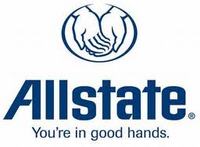Allstate Wants Drivers to See Yellow, Then "LOOK" for Motorcyclists on the Road
 |
NORTHBROOK, IL--May 26, 2011: Twenty-five cities are getting new traffic signs designed to bring awareness to motorcyclists on the road, thanks to Allstate. The insurer will place cautionary signs at intersections in 25 major metropolitan areas to prompt drivers to look out for riders at intersections. An average of three motorcyclists are killed every day at intersections in the United States, and crash data reveals that motorcycle crashes happen more often in intersections than elsewhere, relative to the amount of time riders spend in them.
The caution signs, which are yellow and diamond-shaped, feature a motorcycle silhouette and are inscribed with the word "LOOK" to encourage motorists to look for motorcycles before crossing an intersection. The signs, part of Allstate's "Once is Never Enough" (ONE) program, are designed to increase awareness of motorcycle collisions with motorists at intersections and to help remind drivers and riders alike that looking once at intersections is never enough.
"In the time it takes to blink an eye, a life could be saved," said Keith Rutman, vice president of Allstate's consumer household unit. "Taking one extra second at an intersection to look left, right-- and left again -- for motorcyclists can help make our roads safer."
Allstate encourages both drivers and riders to be conscious that they share the road with each other, and offers the following tips for motorcyclists and motorists to keep in mind next time they hit the road:
Tips for Motorists
- Look left, right -- and left again -- for motorcyclists. Also, be aware that because of a motorcycle's small size, a bike can easily hide in a car's blind spot.
- Be cautious when going through intersections. Almost one-third of motorcycle accidents happen here.
- Allow for greater following distance. Did you know most motorcyclists do not activate their brake light when slowing down? They slow down by downshifting.
- Don't assume motorcyclists are speeding. Due to their small size, motorcycles may seem to be moving faster and appear farther away than they really are.
- Motorcyclists often adjust position within a lane. This helps them be seen more easily by motorists. They also tend to avoid the center of the lane because of liquids that leak from car engines, transmissions and radiators.
Tips for Motorcyclists
- Be cautious when going through intersections. Almost one-third of motorcycle crashes happen here.
- Be visible when you ride. Avoid blind spots, wear bright-colored, protective clothing, activate turn signals early and always use your headlights.
- Flash your brake lights when slowing down. This helps others on the road know your intentions.
- Remember to give yourself space between you and the car in front of you. You'll have more time to react to other motorists' actions.
- Ride within your limits. If you're a new rider, consider taking a training course. Rush hour is not the time to learn how to maneuver your motorcycle. All riders should avoid extreme temperatures and inclement weather.
The ONE program sign installations will be taking place in the following cities:
- Albany, N.Y.
- Atlanta, Ga.
- Charlotte, N.C.
- Chicago, Ill.
- Cincinnati, Ohio
- Columbus, Ohio
- Dallas, Texas
- Denver, Colo.
- Houston, Texas
- Indianapolis, Ind.
- Las Vegas, Nev.
- Los Angeles, Calif.
- Miami, Fla.
- Nashville, Tenn.
- Orlando, Fla.
- Philadelphia, Pa.
- Phoenix, Ariz.
- Sacramento, Calif.
- San Diego, Calif.
- San Francisco, Calif.
- Salt Lake City, Utah
- Seattle, Wash.
- St. Louis, Mo.
- Tampa, Fla.
- Washington, D.C.


